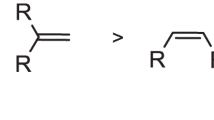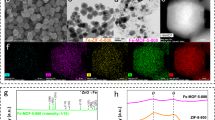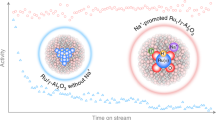Abstract
Replacing noble metals in heterogeneous catalysts by low-cost substitutes has driven scientific and industrial research for more than 100 years. Cheap and ubiquitous iron is especially desirable, because it does not bear potential health risks like, for example, nickel. To purify the ethylene feed for the production of polyethylene, the semi-hydrogenation of acetylene is applied (80 × 106 tons per annum; refs 1, 2, 3). The presence of small and separated transition-metal atom ensembles (so-called site-isolation), and the suppression of hydride formation are beneficial for the catalytic performance4,5,6. Iron catalysts necessitate at least 50 bar and 100 °C for the hydrogenation of unsaturated C–C bonds, showing only limited selectivity towards semi-hydrogenation7,8,9,10,11,12,13. Recent innovation in catalytic semi-hydrogenation is based on computational screening of substitutional alloys to identify promising metal combinations using scaling functions14 and the experimental realization of the site-isolation concept employing structurally well-ordered and in situ stable intermetallic compounds of Ga with Pd (refs 15, 16, 17, 18, 19). The stability enables a knowledge-based development by assigning the observed catalytic properties to the crystal and electronic structures of the intermetallic compounds20,21. Following this approach, we identified the low-cost and environmentally benign intermetallic compound Al13Fe4 as an active and selective semi-hydrogenation catalyst. This knowledge-based development might prove applicable to a wide range of heterogeneously catalysed reactions.
This is a preview of subscription content, access via your institution
Access options
Subscribe to this journal
Receive 12 print issues and online access
$259.00 per year
only $21.58 per issue
Buy this article
- Purchase on Springer Link
- Instant access to full article PDF
Prices may be subject to local taxes which are calculated during checkout



Similar content being viewed by others
References
Piringer, O. G. & Baner, A. L. Plastic Packaging: Interactions with Food and Pharmaceuticals 2nd edn (Wiley, 2008).
Borodzinski, A. & Bond, G. C. Selective hydrogenation of ethyne in ethene-rich streams on palladium catalysts. Part 1. Effect of changes to the catalyst during reaction. Catal. Rev. Sci. Engin. 48, 91–144 (2006).
Borodzinski, A. & Bond, G. C. Selective hydrogenation of ethyne in ethene-rich streams on palladium catalysts, Part 2: Steady-state kinetics and effects of palladium particle size, carbon monoxide, and promoters. Catal. Rev. Sci. Eng. 50, 379–469 (2008).
Ahn, I. Y., Lee, J. H., Kim, S. K. & Moon, S. H. Three-stage deactivation of Pd/SiO2 and Pd–Ag/SiO2 catalysts during the selective hydrogenation of acetylene. Appl. Catal. A 360, 38–42 (2009).
Khan, N. A., Shaikhutdinov, S. & Freund, H-J. Acetylene and ethylene hydrogenation on alumina supported Pd–Ag model catalysts. Catal. Lett. 108, 159–164 (2006).
Derouane, E. G. Second European Symposium on Catalysis by Metals. Multimetallic catalysts in synthesis and transformation of hydrocarbons: Concluding remarks, critical issues and perspectives. J. Mol. Catal. 25, 51–58 (1984).
Paul, R. & Hilly, G. Preparation of an active iron and its application to the semihydrogenation of acetylene derivatives. Bull. Soc. Chim. Fr. 6, 218–223 (1939).
Thompson, A. F. & Wyatt, S. B. Partial reduction of acetylenes to olefins using an iron catalyst. J. Am. Chem. Soc. 62, 2555–2556 (1940).
Reppe, W. Ethynylation. IV. Reactions of α-alkynols and γ-alkynediols. Justus Liebigs Ann. Chem. 596, 38–79 (1955).
Taira, S-I. The Urusibara catalysts. I. Some structural features revealed by X-ray diffraction. Bull. Chem. Soc. Jpn 35, 844–851 (1962).
Nitta, Y., Matsugi, S. & Imanaka, T. Partial hydrogenation of phenylacetylene on copper-promoted iron catalyst. Catal. Lett. 5, 67–72 (1990).
Phua, P-H., Lefort, L., Boogers, J. A. F., Tristany, M. & de Vries, J. G. Soluble iron nanoparticles as cheap and environmentally benign alkene and alkyne hydrogenation catalysts. Chem. Commun. 3747–3749 (2009).
Sabatier, P. & Senderens, J. B. Nouvelles méthodes générales d’hydrogénation et de dédoublement moléculaire basées sur l’emploi des métaux divisés. Ann. Chim. Phys. 4, 319–432 (1905).
Studt, F. et al. Identification of non-precious metal alloy catalysts for selective hydrogenation of acetylene. Science 320, 1320–1322 (2008).
Armbrüster, M. et al. Pd–Ga intermetallic compounds as highly selective semi-hydrogenation catalysts. J. Am. Chem. Soc. 132, 14745–14747 (2010).
Armbrüster, M., Wowsnick, G., Friedrich, M., Heggen, M. & Cardoso-Gil, R. Synthesis and catalytic properties of nanoparticulate intermetallic Ga–Pd compounds. J. Am. Chem. Soc. 133, 9112–9118 (2011).
Kovnir, K. et al. In situ surface characterization of the intermetallic compound PdGa. A highly selective hydrogenation catalyst. Surf. Sci. 603, 1784–1792 (2009).
Osswald, J. et al. Palladium–gallium intermetallic compounds for the selective hydrogenation of acetylene Part II: Surface characterization and catalytic performance. J. Catal. 258, 219–227 (2008).
Osswald, J. et al. Palladium–gallium intermetallic compounds for the selective hydrogenation of acetylene Part I: Preparation and structural investigation under reaction conditions. J. Catal. 258, 210–218 (2008).
Kovnir, K. et al. PdGa and Pd3Ga7: Highly-selective catalysts for the acetylene partial hydrogenation. Stud. Surf. Sci. Catal. 162, 481–488 (2006).
Kovnir, K. et al. A new approach to well-defined, stable and site-isolated catalysts. Sci. Technol. Adv. Mater. 8, 420–427 (2007).
Grin, J., Burkhardt, U., Ellner, M. & Peters, K. Refinement of the Fe4Al13 structure and its relationship to the quasihomological homeotypical structures. Z. Kristallogr. 209, 479–487 (1994).
Gille, P. & Bauer, B. Single crystal growth of Al13Co4 and Al13Fe4 from Al-rich solutions by the Czochralski method. Cryst. Res. Technol. 43, 1161–1167 (2008).
Stampfl, C., Ganduglia-Pirovano, M. V., Reuter, K. & Scheffler, M. Catalysis and corrosion: The theoretical surface-science context. Surf. Sci. 500, 368–394 (2002).
Seah, M. P. et al. Ultra-thin SiO2 on Si IX: Absolute measurements of the amount of silicon oxide as a thickness of SiO2 on Si. Surf. Interface Anal. 41, 430–439 (2009).
Teschner, D. et al. The roles of subsurface carbon and hydrogen in palladium-catalyzed alkyne hydrogenation. Science 320, 86–89 (2008).
Popv, P. et al. Anisotropic physical properties of the Al13Fe4 complex intermetallic and its ternary derivative Al13(Fe,Ni)4 . Phys. Rev. B 81, 184203 (2010).
De Smit, E. & Weckhuysen, B. M. The renaissance of iron-based Fischer–Tropsch synthesis: On the multifaceted catalyst deactivation behaviour. Chem. Soc. Rev. 37, 2758–2781 (2008).
Danafara, F., Fakhru’l-Razi, A., Salleh, M. A. M. & Biak, D. R. A. Fluidized bed catalytic chemical vapor deposition synthesis of carbon nanotubes—a review. Chem. Eng. J. 155, 37–48 (2009).
Powell, C. J. & Jablonski, A. Evaluation of electron inelastic mean free paths for selected elements and compounds. Surf. Interf. Anal. 29, 108–114 (2000).
Acknowledgements
We thank G. Auffermann for chemical analysis, R. Wagner for the UHV preparation of the single crystals and S. Hoffmann as well as E. Kitzelmann for in situ differential thermal analysis and thermal gravimetric measurements. The European Network of Excellence on ‘Complex Metallic Alloys’, contract No. NMP3-CT-2005-500140, the EU FP7 NMI3 Access Programme and the NAP VENEUS grant (OMFB-00184/2006) are acknowledged for supporting this work in part and the in situ PGAA measurements, respectively. Beam time for in situ XPS measurements was provided by the Helmholtz-Zentrum Berlin für Materialien und Energie GmbH (ID 2010_1_90734) and we thank the team of the ISIS-PGM beamline for continuous support. The European Centre for Development of Alloys and Compounds (C-MAC) nurtured this publication by providing a networking platform.
Author information
Authors and Affiliations
Contributions
P.G., M. Hahne, M. Heggen and M. Feuerbacher provided the samples that were characterized by M.A. Catalytic measurements were performed by M.A., K.K. and M. Friedrich, and D.T., G.W., M. Friedrich and M.A. conducted the XPS studies after D.R. prepared the samples. In situ PGAA and XRD experiments were conducted by L.S. and F.G., respectively. R.S. and Y.G. gave conceptual advice and M.A., M. Feuerbacher and D.T. wrote the paper.
Corresponding author
Ethics declarations
Competing interests
The authors declare no competing financial interests.
Supplementary information
Supplementary Information
Supplementary Information (PDF 877 kb)
Rights and permissions
About this article
Cite this article
Armbrüster, M., Kovnir, K., Friedrich, M. et al. Al13Fe4 as a low-cost alternative for palladium in heterogeneous hydrogenation. Nature Mater 11, 690–693 (2012). https://doi.org/10.1038/nmat3347
Received:
Accepted:
Published:
Issue Date:
DOI: https://doi.org/10.1038/nmat3347
This article is cited by
-
Pt-doped Ru nanoparticles loaded on ‘black gold’ plasmonic nanoreactors as air stable reduction catalysts
Nature Communications (2024)
-
Iron phosphide nanocrystals as an air-stable heterogeneous catalyst for liquid-phase nitrile hydrogenation
Nature Communications (2023)
-
Synthesis of core/shell nanocrystals with ordered intermetallic single-atom alloy layers for nitrate electroreduction to ammonia
Nature Synthesis (2023)
-
Non-noble metal-based catalysts for acetylene semihydrogenation: from thermocatalysis to sustainable catalysis
Science China Chemistry (2023)
-
Microstructural characterization of rapidly solidified Al-13.5 at.% Cr and Al-13.5 at.% V alloys for catalytic applications
Journal of Materials Science (2023)



